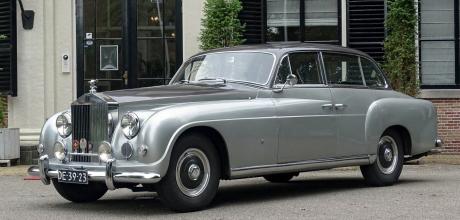1952 Rolls-Royce Silver Dawn by Ghia
This 1952 Silver Dawn wears advanced Italian coachwork that could have signalled a new style for Rolls-Royce’s standard bodies, but instead it remains a glorious one-off.
A NEW DAY?
1952 Rolls-Royce Silver Dawn by Ghia
SILVER DAWN BY GHIA BEHIND THE WHEEL OF A UNIQUE SALOON HAND BUILT IN TURIN
“This remarkable 1952 Silver Dawn was designed and built for the Italian Contessa Ida Matarazzo, and delivered from Rome through Rolls-Royce dealer Fernando Martorelli”
SILVER DAWN BY GHIA
Can it really be from 1952? This sleek Italian body signalled the way ahead for Rolls-Royce
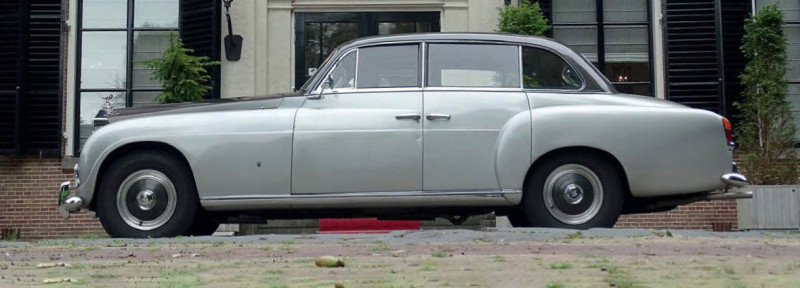
Many illustrious coachbuilders have their roots in Italy – think of Pininfarina, Bertone, Giugiaro, Zagato and many others. Another name that belongs in this list is Ghia. Carrozzeria Ghia was founded in Turin by Giacinto Ghia in 1916 and when the founder died in 1944, his wife offered the company to his colleagues Mario Felice Boano and Giorgio Alberti, on the condition that her husband's name would be preserved. It was. In the early years, Ghia designed special models for marques such as Mercedes-Benz, Jaguar, Volvo, Rolls- Royce and Ferrari, and produced car bodies on a small scale. In total, only two Rolls-Royces were fitted with Ghia bodywork: a Silver Wraith from 1951 (LWOF48) and a Silver Dawn from 1952 (LSHD22). It is this unique Silver Dawn with a Ghia four-door, six-light saloon body that RR&BD has been lucky enough to drive.
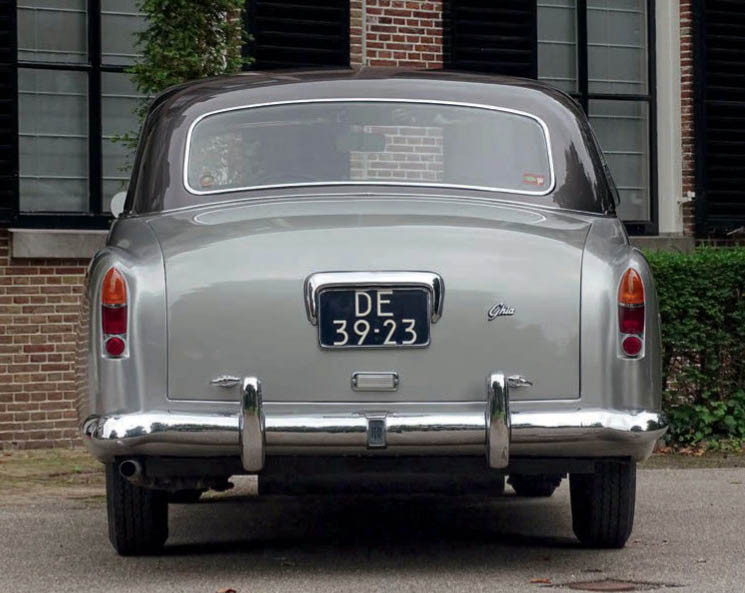
TAKING A SEAT
Before we set off, we have to make room behind the wheel. Most of the classic Rolls-Royces from the first 50 years of production contain front seats with only a small gap between the steering wheel and the squab. This Ghia, however, has the option to slide the front bench and to adjust the space for the front passengers. For that, both front passengers first have to get out. The seat squab can then be removed from the frame and on both sides a latch must be pressed out of lugs, and the frame can be pushed backwards. Coordinated action on both sides increases the chances of success, because the frame doesn't lend itself well to shifting first on one side and then the other. Since this is not an everyday operation and the frame is difficult to move, it takes a lot of strength to slide it only one inch. Later I learned from the owner that the frame has holes through which cables are now installed, so the bench can now be unlocked with a lever and the cushion can remain in place during adjustment. Once inside, I’m struck by the width of the car. The standard Bentley Mk VI and Silver Dawn retained the classic torpedo nose that was a feature of almost all pre-war cars. Such a car has a wide rear compartment, but the driver has significantly less space in the front, because the body tapers in a straight line from the front compartment to the grille. Not this Ghia. This car has sides that run parallel from back to front. The front seat is therefore almost as wide as the rear seat. Since the steering wheel and pedals are arranged as on the standard Silver Dawn with the tapered nose, the driver has to slide a little towards the middle of the seat to sit in line with the steering wheel. That is nice and spacious, but also a bit strange because the driver sits relatively far from the door.
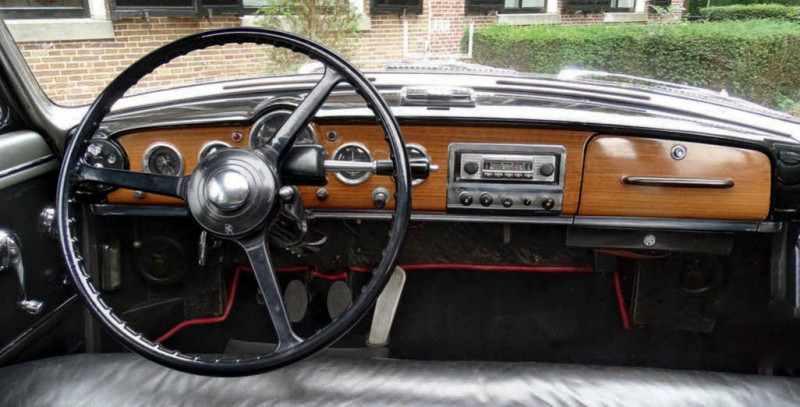
STROLLING AWAY
To start the car, you must begin by turning the key to its correct position, after which the key does no more. The next step is to turn two switches, one for the contact, the other for the ignition. Then you push the starter button. When starting from cold, an automatic choke kicks in and the engine has to run for a few minutes before the revolutions die back to a normal idle speed. We’ll wait a moment, as with a cold engine it is slightly more difficult to run the car smoothly.
Readers used to right-hand drive Rolls-Royce and Bentley cars of this era may not realise that the gear lever of a manual left-hand drive Silver Dawn is on the right-hand side of the steering column, not down by your knee. The lever follows a normal H pattern, with first gear towards you and up, second straight down from there and so on. Reverse gear requires a button to be pressed at the head of the lever before the lever can be pulled further towards the steering wheel and moved upwards. There is no synchromesh on first gear and reverse, so the car must be absolutely stationary before these gears can be engaged. In practice, this (and the engine’s excellent torque) discourages use of first gear.
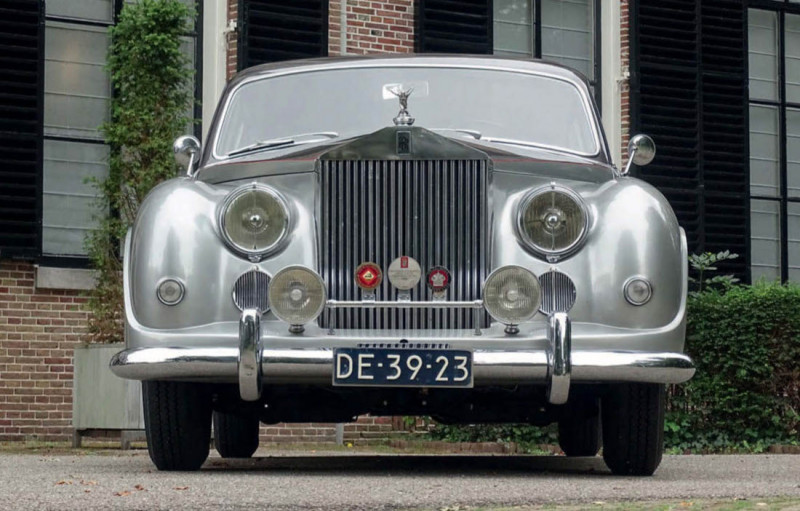
Even when the car has only a little momentum, in second gear it picks up without a murmur and drives off as if it were an automatic. This makes it possible to drive the car in a relaxed and lazy manner; once in top gear, the speed has to fall very low before downshifting is necessary. It gets up to speed quickly and nimbly, and it ambles along the highway at 100 km/h (60 mph) with no protest. Just a little gas is needed for an effortless overtaking manoeuvre and the car accelerates to 120 km/h (70mph) with modern convenience. The Ghia’s flexibility across all normal speeds is amazing.
The car has four drum brakes, but power assistance is only applied to the front wheels. In traffic, the car brakes in a modern, predictable way. The pedal is light to operate and this large saloon stops eagerly and progressively. In 1952 power steering was not yet available to Rolls-Royces. Because the steering wheel was large and the tires were relatively narrow, you only felt the weight of the steering at low speed. This is also the case with this Silver Dawn. At parking speed a little force is needed, but once the car is at bicycle speed, you definitely don't miss the power steering. Perhaps the relatively low weight plays a role here, as it may do with the car’s flexible performance.
Where no less than 1900 kg has to be lashed around the corner in a standard Silver Dawn, the Ghia weighs only 1735 kg and is a lightweight for the Silver Dawn family. Yet on a sloping road surface some attention is needed to stay neatly in the right track, though large corrections are not necessary.
All in all, the feedback from the pedals, gear lever and steering wheel barely suggests a 70 year-old classic car. Everything works very predictably and lightly. The Silver Dawn moves smoothly with the traffic, it brakes and steers neatly and is a user-friendly machine.
LA CONTESSA
This remarkable Silver Dawn was designed and built for an Italian Countess, Contessa Ida Matarazzo, and delivered from Rome through the dealer Fernando Martorelli. It is not clear from the documentation whether the specifications were devised by the Countess, the dealer, or Ghia. In any case, the Silver Dawn chassis arrived at Martorelli on February 14th, 1952 and went straight to Ghia in Turin. In just two months, Ghia constructed the body, getting it ready just in time to exhibit the car at the Turin Motor Show from April 23rd to May 4th 1952. At least, that's what older written sources suggest. Others claim that it was not the Silver Dawn but the Silver Wraith that was on display, and the most recent sources point to this second scenario.
What’s certain is that Ghia designed a body that in no way resembled the standard Silver Dawn. On the contrary, the shape already had many features of the later Silver Cloud. Notable in the design of this car are the noseline, lower by three-quarters of an inch, the grille placed 6 inches further forward with a filler piece to bridge the distance between the grille and the radiator, and the one-piece bonnet that opens at the front. More generally, it’s also set apart by the rounded, convex body lines, the trunk space that continues in one flowing line, the third side window and the pillarless doors. In its original form, however, it wasn’t quite to the Countess’s taste.
Before taking delivery on June 7th, 1952, the Countess commissioned Ghia to reshape the car at the front. Large P100 headlights and a central fog lamp were changed to the current standard Silver Dawn lighting. Immediately after this renovation, the car won the prestigious Grand Prix d'Honneur at Villa Borghese in Rome. Later, around 1960, the Countess also ordered the rear to be modified. The trunk space was extended by approximately 20cm and the rear lights were reshaped.
It didn't stop there. Sometime later, it was fitted with large air slots in the front mudguards, but in 1983 the Silver Dawn was sent to Zurich for a major restoration and the air slots were removed. Furthermore, a metal sunroof was installed.
The Silver Dawn underwent a bare metal respray in which the colour scheme was changed from Tudor Grey over Shell Grey to Black Pearl over Shell Grey. When new, the Silver Dawn was delivered with black leather upholstery in the front and fawn cloth in the rear. Various sources claim that initially a division was built in, but evidence for this was never found. During the restoration in Zurich, the entire interior was reupholstered with black leather.
A WEALTH OF DETAILS
The Silver Dawn Ghia is full of unique details. Not only to look at, but also to use. Seventy years ago, all Rolls-Royces and Bentleys had a right-hand bonnet and a left-hand bonnet, both of which could be unlocked at the side and then carefully folded up. This Ghia opens at the front and the huge panel is then kept at a height via an ingenious mechanism, without having to hook an iron bar underneath to prevent it from collapsing.
Looking at the engine bay, there is significantly more space around the engine than on a standard Silver Dawn saloon, with the tapering nose mentioned previously. There is also no shortage of space in the trunk. The boot lid has two locks, forcing the owner always to use two hands to open it. After opening, the boot lid can be supported on the right side with a rod, with the result that the left side hangs a bit lower.
Curiously, the door windows in both the front and rear have no pillars. When the windows are wound down, the doors seem to have been taken from a sports car. It becomes even weirder when you realize that the rear doors hinge at the rear. The doors therefore open in the same way as those of the recent Phantom VIII and Ghost. With the windows down, that's a somewhat unusual sight. However, when all windows are lowered, the front doors retain small side windows or quarterlights that can be opened over an imaginary vertical axis. There is a much larger quarterlight behind each rear door; these can be opened on a hinge.
All in all, the car has a lot of glass area and the view of the traffic is exceptionally good for a Rolls-Royce. That's nice, because the mirrors are no better than those of other Rolls- Royces from that time, and that's not spectacular. Due to the high placement of the rear window, the rear of the car cannot be seen from behind the wheel and the length of the wings at the front is also difficult to estimate, so care is needed when manoeuvring.
The doors are a remarkable design but the rear section of the car also attracts attention. The rear overhang (the bodywork behind the rear axle) is — compared to the overall proportions — remarkably large. This makes it look like the rear axle is too far forward, but the position of the rear axle is normal for the standard Silver Dawn chassis. The rear window is strongly reminiscent of that of a Mercedes-Benz ‘Ponton’ from a year or so later. The overall appearance of the back is therefore somewhat anonymous and to my eyes, a bit strange. In the 1980s, a metal sunroof was fitted to the car. It can easily be cranked open and provides striking light for a classic of this age. The interior sports more unique details. The dashboard appears to have been made of wood, but it’s not. It is aluminium and the wood grain has been painted on. The effect is so realistic you’d probably never notice unless someone pointed it out. Also the rather large steel bezels around the instruments do not have a standard Rolls-Royce shape. In short, Ghia has succeeded well in building in its very own instrument panel. Generally speaking, apart from the kneeling lady on the grille, hardly anything of this car reminds us of the original Silver Dawn.
RIDING IN THE REAR
Getting into the back seats of the standard saloon Bentley Mk VI and Silver Dawn is a tricky movement. The armrests of the rear seats protrude far forward so that the passenger has to make a weird twist to move in without hitting them. In this Ghia too, the armrests protrude forward, but less emphatically than in the standard saloon. Yet, the passenger must enter with care, because Ghia has decided to build in fragile cigar lighters on the end of the armrests. If the entry is perhaps a bit awkward, the seating in the back is generous and comfortable. Beautifully braided cords have been applied to the rear of the front seat to make it easier to get in. But despite the fact that the car was initially called a limousine, the rear passengers have no special pleasures at their disposal such as a drinks cabinet or their own radio.
On the move, small irregularities are neatly absorbed and there is a high degree of comfort, up to the standards expected of the Rolls-Royce name. But whether it is due to the large overhang or the Silver Dawn’s rather old-fashioned construction, the rear bounces higher than you would expect when rebounding from bumps. The driver (or chauffeur) can do something about this, though. On the right side of the steering wheel boss there is a control to adjust the rear shock absorbers, marked RIDING. When this is adjusted from NORMAL to HARD, your concerns about rebounding off the bumps are over.
IN SHORT
The Silver Dawn by Ghia may seem relatively inconspicuous, but on the road you can tell people know it’s something special. The admiring glances and thumbs-up signals are numerous. The car is superbly comfortable to sit in and to drive, it can withstand the busy traffic of 2022 and is not too heavy to operate. When driving, it feels more like a young-timer than a 70-year-old classic. Indeed, you could almost use it for daily transport. What would prevent me from doing so is the lack of safety features such as seat belts, airbags, head restraints, ABS and the presence of elderly features such as an outdated starting procedure, two unsynchronized gears, a rotary knob positioned on the dashboard for the indicators, and the like.
It offers a lot of space, a lot of comfort, mechanical excellence and the unique appeal of that one-off body. It is above all a car that can easily and frequently be used for pleasure rides and long European classic tours.
ABOUT THE AUTHOR
Marinus Rijkers runs two of the most useful and informative websites for enthusiasts of all SY- and SZ-series models. You can find them at RRSilverShadow.com and RRSilverSpirit.com. He has also written a couple of books, which can be found at RRBspecialist.com.
“The Silver Dawn by Ghia may seem relatively inconspicuous, but on the road you can tell people know it’s something special.”
THE ROLLS ROYCE SILVER DAWN
GHIA LIMOUSINE IN NUMBERS
- Chassis number LSHD22
- Year 1952
- Length, width, height 5072, 1985, 1590mm (determined by measuring)
- Wheelbase Standard saloon: 120 inch = ca. 3048 mm
- Track Standard saloon: front 56,5 inch = 1435 mm; rear 58,5 inch = 1486 mm
- Turning circle Standard saloon: 41 ft 2 inch = 494 inch = ca. 12,5 m
- Curb Weight 1735 kg (determined by weighing)
- Top speed Standard saloon: 144 km/h
- Engine 4566 cc 6-cylinder inline engine (big bore engine)
- Power 150 pk (148 bhp)
- Gear box Manual 4-speed gear box; 2nd, 3rd and 4th gear synchronised
OWNER HISTORY
- 1952 – 1973Contessa Ida Matarazzo, Rome, Italy
- 1973 – 1976 Sr. Pantanella, Italy
- 1976 – 1980 Tony Frey collection, Luzern, Switzerland
- 1980 – 1983 K.H. Eikholt, President of the German section of the RREC, Munich, Germany
- 1983 – 1989 Thomas T. Solley, Indiana, USA
- 1989 – 2019 Jan de Boer, the Netherlands
- 2019 – 2021Gallery Aaldering, the Netherlands
- 2021. PRESENT Peter van den Brandt, the Netherlands
DAWN OF HISTORY
The Rolls-Royce Silver Dawn came on the market in 1949 and was derived from the Bentley Mk VI. America, especially, was quite interested in a Rolls-Royce version of the Bentley Mk VI and from 1949 left-hand drive Silver Dawns were produced for the American market. These were almost identical to the Bentley Mk VI in both design and technology and were completely assembled by the factory, in standard form. In 1951 the six-cylinder engine was bored out from 4257cc to 4566cc. This more powerful engine became known as the ‘big bore’ in the Mk VI. In 1952 the Mk VI was succeeded by the Bentley R-Type which differed essentially from the Mk VI by a significantly modified rear. The Rolls-Royce Silver Dawn did not change its name and piggybacked on the upgrades of the Bentley. The car on these pages, being a 1952 chassis, is based on the Mk VI ‘big bore’ specification.
Above: The rear door is rear-hinged, the front door is front-hinged. The wind-down window in each door is frameless. To make it work, the B pillar needs to be a remarkable shape.
standard Silver Dawn has a wooden dashboard with dials and gauges gathered in the centre. Ghia chose a more modern layout made in aluminium, with a painted woodgrain finish.
Above: The bonnet consists of one large panel and remains open at the front without additional supports.
Sometime before the mid-Eighties restoration, these large air-slots were fitted. They were removed during refurbishment. (Source picture unknown; the picture has been printed in several books)


